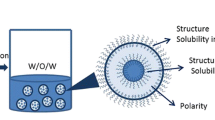Abstract
The system water–benzene–ethanol was used to illustrate the complexity of spontaneous emulsification, when water-poor emulsions are brought in contact with water. In the first case, an O/W emulsion located close to the plait point in the system was used. The aqueous phase in the emulsion was incompatible with water, and a strong spontaneous emulsification to an O/W between the two liquids took place in the water layer close to the interface between layers. In the second case, a W/O emulsion, also close to the plait point, was brought in contact with water. Now, the spontaneous emulsification between the water and the oil phase of the original emulsion to an O/W emulsion also took place in the water layer forming a distinct emulsion layer beneath the interface.






Similar content being viewed by others
Reference
Gad J, Fettresorption ZL (1878) Arch Anat Physiol 12:112–119
Davies JT, Rideal SEK (1963) Interfacial phenomena. Academic Press, NY, p 480
Salager JL, Forgiarini A, Márquez L, Peña A, Pizzino A, MaP R, Rondón-González M (2004) Using emulsion inversion in industrial processes. Adv Colloid Interface Sci 108–109:259–272. doi:10.1016/j.cis.2003.10.008
Ruschak KJ, Miller CA (1972) Spontaneous emulsification in ternary systems with mass transfer. Ind Eng Chem Fundam 11(4):534–540. doi:10.1021/i160044a017
Miller CA (1988) Spontaneous emulsification produced by diffusion—a review. Colloids Surf A 29(1):89–102. doi:10.1016/0166-6622(88)80173-2
Tauer K, Kozempel S, Rother G (2007) The interface engine: experimental consequences. J Colloid Interface Sci 312(2):432–438. doi:10.1016/j.jcis.2007.03.022
Shahidzadeh N, Bonn D, Meunier J, Nabavi M, Airiau M, Morvan M (2000) Dynamics of spontaneous emulsification for fabrication of oil in water emulsions. Langmuir 16(25):9703–9708. doi:10.1021/la000493l
Toxvaerd S (2004) Droplet formation in a ternary-fluid mixture: spontaneous emulsion and micelle formation. J Phys Chem A 108(41):8641–8645. doi:10.1021/jp049112t
Grillo I (2003) Small-angle neutron scattering study of a world-wide known emulsion: Le Pastis. Colloids Surf A 225(1–3):153–160. doi:10.1016/s0927-7757(03)00331-5
Sitnikova NL, Sprik R, Wegdam G, Eiser E (2005) Spontaneously formed trans-anethol/water/alcohol emulsions: mechanism of formation and stability. Langmuir 21(16):7083–7089. doi:10.1021/la046816l
López-Montilla J, James M, Crisalle O, Shah D (2005) Surfactants and protocols to induce spontaneous emulsification and enhance detergency. J Surfactants Deterg 8(1):45–53. doi:10.1007/s11743-005-0329-3
Miller CA, Raney KH (1993) Solubilization-emulsification mechanisms of detergency. Colloids Surf A 74(2–3):169–215. doi:10.1016/0927-7757(93)80263-e
Bozeya A, Al-Bawab A, Friberg S, C.Miller (2013). J Dispersion Sci Technol (In press)
Varteressian KA, Fenske MR (1936) LIQUID-LIQUID EXTRACTION performance of a packed extraction column, using continuous countercurrent. Ind Eng Chem 28(8)
Brandani V, Chianese A, Rossi M (1985) Ternary liquid-liquid equilibrium data for the water–ethanol–benzene system. J Chem Eng Data 30(1):27–29. doi:10.1021/je00039a009
Lee K, Peters C (2004) UNIFAC modeling of cosolvent phase partitioning in nonaqueous phase liquid-water systems. J Environ Eng 130(4):478–483. doi:10.1061/(ASCE)0733-9372(2004)130:4(478)
Lee K (2010) Model to describe the binodal curve on a type 1 ternary phase diagram. J Environ Eng 136(6). doi:10.1061/(ASCE)EE.1943-7870.0000196
Acknowledgments
The authors thank Hamdi Mango Center for Scientific Research for providing a very suitable and well-equipped working environment, where all the experiments took place in its laboratories, and the CIES Fulbright Specialist Program, Washington, DC, for a grant to SEF. This work was financially supported by the National Nature Science Foundation of China (no. 21073156, no. 21203162).
Author information
Authors and Affiliations
Corresponding author
Rights and permissions
About this article
Cite this article
Bozeya, A.A., Al-Bawab, A.F., Friberg, S.E. et al. Some experiments on complex spontaneous emulsification in the system water–benzene–ethanol. Colloid Polym Sci 291, 1933–1938 (2013). https://doi.org/10.1007/s00396-013-2932-y
Received:
Revised:
Accepted:
Published:
Issue Date:
DOI: https://doi.org/10.1007/s00396-013-2932-y




